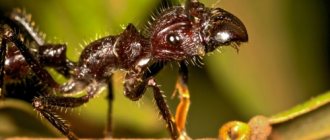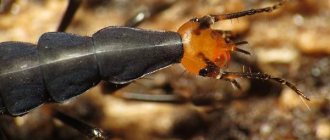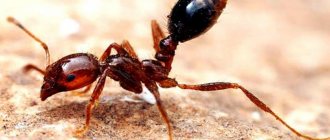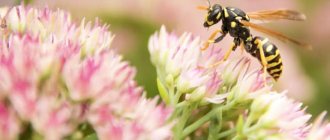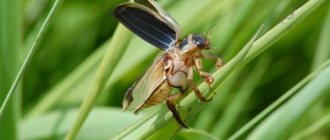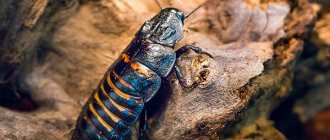Description
Wood ants have a large body, the length of which reaches 1.5 cm. The head is disproportionately large compared to the small chest. Long antennae necessary for touch are localized on it. The males of these insects are visually very different from the females.
Male wood ants have a darker body and red or yellow legs . In addition, they have wings. Female forest representatives have a smaller body of a red-brown color.
They only have wings during the mating season, and then they chew them off. Working individuals are also red-brown and without wings.
Ant larvae have an elongated, large, white body, covered with hairs. During molting, they turn into pupae. To leave the pupa, insects are helped by workers. They break the cocoon, and the young wood ant becomes a full-fledged member of the community.
Colony of pharaoh ants
A colony of red house ants differs from a colony of forest ants in that several queens can simultaneously exist and reproduce in it. Moreover, domestic red ants constantly actively create daughter nests - in the kitchen, in pantries, in front doors - having close ties with the main colony, but feeding independently and increasing their numbers. If one such nest dies, the entire colony remains unharmed. This is why pharaoh ants are so difficult to remove from indoors.
The queen of red house ants (pictured on the right) lives 4-5 years, she is larger than the worker ants and has a characteristic color:
It is interesting to note that despite the most important function for the colony, the queen of the red house ant is not a “queen” at all - worker ants calmly kill queens that stop working, or exchange them between anthills.
In general, if there are red ants at home, you should prepare for a difficult and very lengthy fight - in most cases, you won’t be able to get them out in a day or two. But if you know what red ants are afraid of, it is quite possible to get rid of them by systematically using the necessary means.
Peculiarities
The red forest ant has the following features:
- The insect's abdomen has a gland filled with a toxic substance. Forest dwellers use it to protect themselves from enemies. The poison is very painful. Even people feel discomfort from it. And with multiple bites, an allergic reaction can be provoked.
- Wood ants are completely deprived of the organ of hearing, so they do not hear anything. In contrast to this, they have a well-developed sense of smell. Thanks to him, these forest inhabitants can freely navigate the terrain and find prey.
- The organ of vision in forest ants does not work at full capacity. They see, but only violet shades.
- The insect has powerful jaws. Their mouthparts perform several tasks at once: construction, defense, and grasping prey. And also with their help, insects carry eggs and larvae.
Working individuals of red forest ants live 5-6 years, and queens live up to 20 years.
Red myrmica
Myrmica is a species of small red ants, about four to five centimeters long. The body has a color from yellow to red and brown. This species is most common in Eurasia. Such forest ants are often found in meadows and vegetable gardens, competing with the well-known black ones. An interesting fact is that they have mastered not only wild nature, but also urban landscapes. To protect themselves, small red ants use a sting and poison, which has a rather painful effect on the body, especially when the bites are numerous. Sometimes people have an allergic reaction due to the ingress of acid (formic).
Varieties
Red forest ants have the following classification:
- Small or forest bareback. Its body length is 7-14 mm, color is red-brown. Found in the temperate zone of northern Eurasia. They create large anthills from needles and twigs (up to 2 m in height).
- Northern forest. Found in temperate forests of Eurasia. Listed on the red list of threatened species.
- Hairy forest. The length of working ants is 4-9 mm, and females and males reach 9-11 mm. They are also listed in the Red Book.
In addition, there are blood ants and black-brown wood ants.
Lifestyle
The small forest ant is often found in deciduous, coniferous or mixed forests that have existed for 20-30 years. In the summer, insects are very active, and in the winter they hibernate underground. Forest representatives, like all other species of these insects, are very hardworking.
Forest ants create colonies that live in anthills-nests. They build them in the ground, wood or under stones. Forest insects are well organized. All members of the family have clearly assigned responsibilities.
Forest ants are divided into several castes:
- Females (queens or queens). Representatives of the female species lay eggs. From them, male representatives of the family emerge (from eggs that were not fertilized) and female individuals (from eggs that were fertilized). The body of the queen is noticeably larger than that of males and worker ants. The only long-lived person in the colony is the queen.
- Males. The task of male ants is to participate in mating. After a while, they are destroyed by other relatives from the anthill. Males are smaller than females. They have wings, but they only live 2-3 weeks.
- Foragers (working individuals). These are female representatives whose reproductive system is underdeveloped. They build an anthill and care for their offspring. Their size is significantly smaller than the uterus. They don't have wings.
- Soldier ants. These working members of the family have a large head and highly developed jaws. They duplicate the duties of worker ants and also protect their nest from enemy invasions.
The female mates only once in her life. The resulting male material is enough for her to produce offspring throughout her life (10-20 years).
Who are ants?
Ants are a family of insects and a superfamily of Ants. It should be noted that these are the most numerous representatives of the entire family. Why are these creatures so interesting? Despite their small size, they have a rather complex organization of their society. There is even a whole science that studies ants and their behavior, called myrmecology.
It is difficult to describe all the diversity of these insects, and therefore we will only talk about forest ants, which we often encounter. In the middle part of Eurasia, as a rule, three varieties can be found. I would like to talk about them in more detail.
Nutrition
The small forest ant eats absolutely everything. Any insects and their larvae are the basis of the diet of forest ants. Therefore, all trees that grow next to the anthill are reliably protected from pests. In addition, ants love plant sap, as well as the sugary secretions of aphids.
The food suppliers in the anthill are the older workers . More aggressive members of the family engage in hunting. When attacking a victim, the ant paralyzes it with a special acid.
Then he drags the immobilized victim into the anthill. There it is divided into pieces and distributed among adult relatives and individuals.
A hungry relative can get food by tapping his antennae on the forager's head. He will immediately give him a small portion of food. Having satisfied his hunger, he takes the rest of the food deep into the nest, where he feeds other ants, as well as their larvae.
If the forager breaks the rules and does not bring food to the anthill or does not want to share, then they do not stand on ceremony with him for a long time and eat them.
Among the workers there are nannies who care for eggs, larvae and nymphs. They deserve a good portion of food. They spend a lot of effort dragging their offspring from chamber to chamber in order to provide them with suitable development conditions according to age characteristics. Wood ants also collect the sweetish secretions of aphids. In one season they manage to prepare up to 20 kg of such food.
Reproduction
New male and female individuals from the eggs laid by the uterus are born in the spring. On a warm day after rain, females and males with wings leave the nest.
Having flown 30-40 meters from the anthill, they land and begin mating. After this, the female bites off her wings, forms a new colony or returns to her previous home.
After intercourse, all male ants die. The new queen lays 10 eggs every day . And the workers take care of the offspring. Nymphs produce a special liquid that forms thin webs when exposed to air. Cocoons are spun from them. After 1.5 months, a young forest ant appears.
Young insects have a soft body, a light red chest, and a gray head and chest. After 2-3 days, the chitinous cover gradually hardens, and the ant acquires the color of an adult. At this stage, the teenager loses the guardianship of his older relatives and begins to work on an equal basis with everyone else.
The queen controls her colony, and the ants recognize each other thanks to special pheromones. When forest ants from different colonies meet, it is difficult to avoid a fight.
Aliens bite each other and spray formic acid. They also attract their relatives to help. There are even massive battles that last 2-3 days in a row.
How ants get into an apartment
When considering the reasons for the appearance of ants in an apartment, we should talk separately about wild ants - inhabitants of gardens, fields and forests - and domestic, pharaoh ants.
Forest red ants, large black field harvester ants or slender garden black ants appear in an apartment by chance and for several reasons:
- They are accidentally carried on clothes or equipment from the street. In this case, one cannot say that ants have appeared in the apartment: encounters with such aliens are rare, and they will not be able to survive in the room for a long time.
- Ants can wander into an apartment from the street in search of food. In this case, insects also do not populate the room: their nest remains on the street, and only foragers looking for food enter the apartment.
In the first case, no measures can be taken at all, and the found ant or several should simply be thrown out the window. The second situation is more complicated: if street ants are found regularly in an apartment, you need to do everything necessary to eliminate their entry points into the room. For example:
- trace through which cracks insects enter the apartment and caulk them
- treat door and window frames with special products
- check the floors on the balconies, ventilation shafts and points of entry and exit of pipes into the apartment - perhaps ants are entering the room from neighbors. The found “gates” are treated with insecticides or covered with putty.
It’s another matter if small ants appeared in the apartment, sometimes catching your eye in whole columns. Here you no longer need to guess why they suddenly decided to occupy an apartment: human housing is the only suitable habitat for them, here they look for food and reproduce.
It is much more reasonable to find out where the ants in the apartment come from: you may have to cooperate with your neighbors to fight them, and after removing them, cut off the paths of re-entry into the room.
So, where do ants come from in an apartment? There may be several options:
- from neighbors' apartments
- from front doors, garbage chutes and dryers
- from the basements
- from the establishments attached to the house
- from a remote room on a person’s clothing or with various household items - in this case, only a random “traveling queen” can start a new colony, and therefore this path is the most rare.
The spread of ants is the key to the survival of their colonies. Moreover, for the pharaoh ant, one colony with nests connected to each other can be located on several floors of a house in dozens of apartments.
The photo shows red ants on the so-called “forage” path. Along these paths, worker ants carry food to the nest:
Benefits and harms
Wood ants are useful in such areas:
- The formic alcohol secreted by these insects is used for medicinal purposes.
- Ant passages are beneficial for the soil - through them it is enriched with oxygen.
- An insect colony prevents pests from multiplying excessively.
The bites of these insects are dangerous for humans. Formic acid causes swelling, itching, headache and disturbance of spatial orientation. In allergy sufferers, this substance provokes anaphylactic shock.
In addition, if a forest ant lives close to a person, then the garden will suffer from an invasion of aphids, which the ants grow.
Yet these forest insects are important to the balance of the ecosystem. People should remember this when they have a desire to stir up or destroy an ant house out of curiosity.
